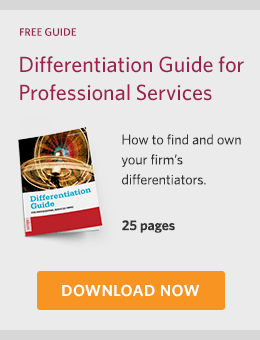When firms decide to identify their differentiators, the story tends to take a certain predictable shape. Stop me if you’ve heard this one before…
Everyone sits down around the conference table and shares their thoughts on the big question: How are we different from our competition? Now and then, a brave soul will even broach the question’s scarier, often-unspoken corollary: Are we different?
After a lot of back and forth, most firms end up with variations on a handful of old standbys. “We care about our clients.” “We do quality work.” “We have great people.”
Sound familiar?
The Wrong Approach
At the end of such a meeting, the folks at these firms usually come away imagining that they’ve isolated their differentiators – but they haven’t. Instead, they’ve left with something very different, the false comfort of sounding just like their competitors.
Consciously or unconsciously, we tend to assume our competitors know something we don’t and model ourselves accordingly. That leads to a glut of false differentiators. Generally speaking, you’re not going to find your differentiators around your conference room table.
A Better Approach
But how can you find them? And once you’ve identified your differentiators, what’s next? The five steps below will help you find a real differentiator for your firm – and not just find it, but own it.
1. Choose an approach to differentiation
There are two basic approaches to identifying your differentiators. You’ll need to understand and weigh your options before you proceed. At the highest level, the two approaches are:
- Making conscious management decisions that differentiate your firm from the competition. Put another way, you can decide how you will be different.
- Discovering the existing characteristics that distinguish your firm. This is a process of discovering differences, not creating them.
Both paths are legitimate and can be effective when carried out correctly. The first approach is more proactive. It requires a high capacity for boldness and improvisation and could mean making significant changes to the nature and direction of your business.
The second approach is a bit more passive, relatively speaking. But it can yield tremendous benefits to firms that aren’t situated or seeking to make dramatic changes in direction.
Here’s some good news. It’s entirely possible for a firm to explore both paths at once, because the way forward for both approaches is the same: research.
2. Assess possible differentiators through research
Whether you’re considering new, differentiated directions for your firm or trying to understand your existing differentiators, you’re going to want to conduct research on yourself and on the marketplace. Why? Time and time again, we’ve seen that firms misperceive their audiences’ priorities, their own relevance to client needs, and even who their competitors are.
In fact, our extensive studies on the topic have shown just how widespread the ‘perception gap’ problem is. Research empowers you to base your decisions on facts rather than hunches.
 If you’re exploring conscious changes in direction, research may help you specialize based on what you learn about your success with particular types of clients. Perhaps you’ve worked particularly well with smaller clients, for example. This finding may be an avenue for specialization, and that specialty could make for an effective differentiator.
If you’re exploring conscious changes in direction, research may help you specialize based on what you learn about your success with particular types of clients. Perhaps you’ve worked particularly well with smaller clients, for example. This finding may be an avenue for specialization, and that specialty could make for an effective differentiator.
Similarly, you could research several industries where you do work and find one that seems to afford the most opportunity. You may discover emerging issues, business models, or unmet needs that you’re particularly well-suited to address. Research is your ear to the ground, helping you objectively evaluate opportunities for differentiation.
How about the ‘discovery’ approach? This generally requires marketplace research on your clients, influencers, and prospects to understand how your firm is seen. Is there anything you do that strikes these audiences as different, unique, or valuable? Is there anything you’re considering that stands out as being worthwhile?
Your clients and prospective clients may identify an aspect or characteristic of your firm that you haven’t recognized, simply because it’s business as usual for you. For example, they may tell you that you’re unusually focused on return on investment. Perhaps you didn’t realize that other firms didn’t share your tireless focus on demonstrating and delivering ROI.
Or perhaps you’ve configured your services in a way that other people haven’t – offering subscriptions in an industry that typically doesn’t – but that difference isn’t obvious to you. Taking advantage of external perspectives will help you see yourself as the marketplace sees you, and these fresh eyes can be invaluable.
3. Identify the differentiators you want to pursue
Now that you’ve explored potential differentiators through research, it’s time to choose the ones that you will focus on to define your firm in the marketplace. Take a look at our 21 ways to differentiate your firm and consider how you might combine some of the differentiators you’ve identified to craft a unique identity.
Emphasizing a given quality of your firm or taking a given direction will surely come with distinct advantages and disadvantages. Every differentiator has a downside as well as an upside. If you decide to focus on serving small firms, you may be discounting opportunities with larger firms. But that focus could be the right direction for you.
Consider the pros and cons, consider what kind of firm you want to be, and consider where opportunity and true distinction lies. Then select your differentiators accordingly.
4. Validating with the marketplace
Remember: the differentiators you choose need to be true, relevant to your audience, and supportable. Once you’ve identified your differentiators – either the existing qualities you mean to emphasize or those that you’re setting out to claim through a new direction for your business – it’s important to validate them with the marketplace.
Say you’ve identified an unmet need in the marketplace and you believe you’re well-suited to meet it. Great! If you’re planning to turn your firm’s attention and resources toward this new offering, however, you’ll want to verify that it’s relevant and that you can carry it out, perhaps through additional marketplace research or small-scale experimentation with the new offering.
Similarly, once you’ve identified an idea about what makes you different, you may need to conduct additional research to ensure that you can back up the claim effectively. Evaluate your proposed differentiators to see whether competitors are taking a similar tack, and to make certain that what you’ve identified is true, relevant, and supportable.
5. Living your differentiators
Planning, of course, is only the first step. Once you’ve validated your differentiators, it’s time to live them out, proving and re-proving them every day.
Now, bear in mind that some differentiators are easier to prove than others. If you say, “our specialty is working exclusively with female entrepreneurs,” audiences will know pretty quickly whether or not you can back that up.
Other differentiating claims, like “Our customer service is demonstrably better than the competition,” might require more work to support. For these broader differentiators, you’ll need more than testimonials – you might need a thorough study, something going much deeper than an assertion. And you will need to back it up with policies and training to make it real and lasting.
And your differentiators must be communicated. Ensure that your website and marketing materials describe, reflect, and prove your differentiators. Likewise for the way you talk to people – make sure that in professional communications, everyone from senior leadership to business development to human resources to marketing communicates in a way that speaks to your differentiators. If no one knows it, it’s not a differentiator.
The Bottom Line on Differentiators
It’s essential to remember that no matter how you arrive at an effective differentiator, it’s more than a lofty idea. It is who you are as a firm. When a differentiator is working as it should, it’s a guiding imperative, expressing itself in your firm’s every action.
You have to live your differentiators every day, working and acting in ways that are consistent with them. The work is continuous, and if you do it well, it can drive you to new levels of success.
On Twitter or LinkedIn? Follow us @hingemarketing and join us on LinkedIn.


